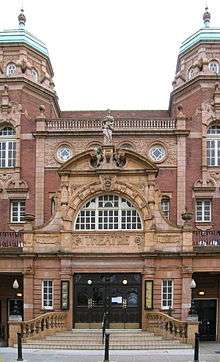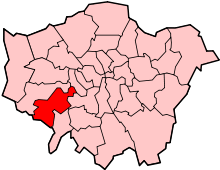Richmond Theatre
|
1899 Richmond Theatre and Opera House 1902 Prince of Wales 1909 Richmond Hippodrome Theatre Royal, Richmond Theatre on the Green | |
 | |
| Location | Richmond, London |
|---|---|
| Coordinates | 51°27′43″N 0°18′14″W / 51.46206°N 0.30381°W |
| Public transit |
|
| Owner | Ambassador Theatre Group |
| Designation | Grade II* |
| Type | Provincial |
| Capacity | 840 |
| Construction | |
| Opened | 18 September 1899 |
| Architect | Frank Matcham |
| Website | |
| Richmond Theatre website at Ambassador Theatre Group | |
Listed Building – Grade II* | |
| Official name | Richmond Theatre |
| Designated | 28 June 1972 |
| Reference no. | 1065384 |
The present Richmond Theatre, in the London Borough of Richmond upon Thames, is a British Victorian theatre located on Little Green, adjacent to Richmond Green. It opened on 18 September 1899 with a performance of As You Like It. One of the finest surviving examples of the work of theatre architect Frank Matcham, the building, in red brick with buff terracotta, is listed Grade II* by Historic England.[1] John Earl, writing in 1982, described it as: "Of outstanding importance as the most completely preserved Matcham theatre in Greater London and one of his most satisfying interiors."[2]
History


The theatre, originally known as the Richmond Theatre and Opera House, is structured into the familiar stalls, dress and upper circles, with four boxes at dress level. The auditorium is a mixture of gilt detailing and red plush fabrics, covering seats and front of circles. Its interior and exterior has been used as a movie set in many films (e.g. Evita, Topsy-Turvy, standing in for the Victorian Savoy Theatre, Finding Neverland – doubling as the Duke of York's Theatre, National Treasure: Book of Secrets – setting of Ford's Theatre) and TV programmes (e.g. Jonathan Creek).
In the early 1990s the theatre underwent a major overhaul overseen by the designer Carl Toms. This included a side extension giving more space for the audience and includes a 'Matcham Room’. The driving force behind the renovation of the theatre was Sally Greene, with strong support from Richmond upon Thames Council through its Chief Executive, Richard Harbord and Community Services Committee chairman Serge Lourie.
The theatre is now part of the Ambassador Theatre Group and has a weekly schedule of plays and musicals, usually given by professional touring companies. Pre-West End shows can sometimes be seen. There is a Christmas and New Year pantomime tradition and many of Britain's greatest music hall and pantomime performers have appeared there.
References
- ↑ Historic England. "Richmond Theatre (1065384)". National Heritage List for England.
- ↑ John Earl, contributor to Curtains!!! or a New Life for Old Theatres, John Offord Publications Ltd (London 1982) ISBN 0903931427
Sources
- Guide to British Theatres 1750–1950, John Earl and Michael Sell pp. 134–5 (Theatres Trust, 2000) ISBN 0-7136-5688-3
